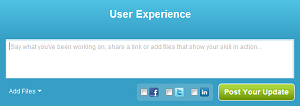Author Archives: Deirdre Kelly
Skill Highlight: User Testing
Editor’s note: User Testing is now being acknowledged more and more by companies as an essential part of the business. However, the labour market is not yet flooded with people skilled in the area. By identifying a small skills gap like this you can educate yourself in more relevant and useful skills.
User Testing is one of the main roles in a User Experience (UX) department, and is the most effective method for evaluating the overall usability of your product. Conducting user tests can take time and effort to set up, but the reward is definitely worth it. You can’t predict how users will interact with your product until you see them in action.
It’s great to see user testing become more prominent and frequent, especially in web design. As a result, many new jobs are created every day for people with UX skills. It’s different for all companies – some may have a dedicated person or even a whole team working on UX, but for others it’s a small part of one person’s role. Either way it’s a skill worth developing.
My advice is to dive in and get learning. A great article to start with is this review of usability and user experience testing tools by Smashing Magazine. Also, check out my previous post on the 7 essential steps for in-person testing. Whatever process you choose, be sure to work with an experienced tester. They should be familiar with the overall process, and have a confident approach to the method. Choosing your testers wisely will help produce very rewarding results.
 Using SkillPages to collaborate with user experience professionals is a great way to learn from others. When you are ready to share what you know, create a SkillPage for your relevant UX skill. Keep it updated with work examples or anything that demonstrates your knowledge. It really is worthwhile – after all I was hired because of my SkillPages’ profile!
Using SkillPages to collaborate with user experience professionals is a great way to learn from others. When you are ready to share what you know, create a SkillPage for your relevant UX skill. Keep it updated with work examples or anything that demonstrates your knowledge. It really is worthwhile – after all I was hired because of my SkillPages’ profile!
For advice on how to manage your SkillPages’ profile, read the 8 tips to get your skills found.
Also, feel free to get in touch with me.
7 Essential Steps for In-Person Usability Testing
Here at SkillPages we like to ensure that all our users have good experiences when using the site. That is why User Experience (UX) is one of those precious arteries which keep the heart of SkillPages ticking nicely.

Usability testing is often thought to be time-consuming and expensive and so gets put down the bottom of a long list of tasks – this shouldn’t, and doesn’t have to be the case. Testing can be lengthy and expensive if outsourced, but there are much faster and cheaper options out there which work just as well, if not better! I’m a big fan of Do-It-Yourself testing, not just for its lower costs and efficiency, but because… seeing is believing.
There are many user testing methods to choose from (that’s a post for another day), and all of these will achieve different results. Choose your method wisely and always keep in mind, your end-user and the results you wish to obtain, but most of all, keep it simple!
The following list of steps for in-person usability testing should see you well on your way to implementing or improving the overall user experience of your website/product.
1.Start
The most important step of all. Don’t put off testing until you think there is something more substantial to test; start testing and do it as early as possible. Even if you only have sketches, wireframes, mock-ups etc., test them. You’ll be surprised by the insights they will reveal, and this will save you time in the long run.
2.Plan
Make a plan for user testing and establish the purpose, goals, and objectives. Make considerations for costs, selecting participants, ethical consent, the test method, user tasks, time-scales, the test environment and how you will analyse the data collected.
3. Recruit
Determine the number of participants to be tested depending on their availability and your resources. Source participants through existing databases, market research groups, colleges, referrals etc., but try to keep it casual and personable. Screen your participants for the requirements you desire and select these, include some least competent users also. Schedule and confirm participants at suitable times.
4. Create Tasks & Scenarios
Keeping your goals in mind, create a brief scenario which describes the situation the tester needs to consider. Write short, direct user tasks and consider the materials needed to carry out the tasks. Make note of what a successful completion of the task should entail and plan task timings. Read the rest of this entry




